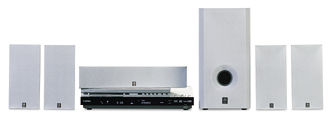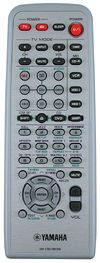Yamaha DVX-S100 HTIB -
Adrienne Maxwell, January, 2003
Yamaha's DVX-S100 has all the makings of a good HTIB.
Like the proverbial chain, a home-theater-in-a-box is only as strong as its weakest link. What's the point in putting outstanding speakers in your HTIB if you top them off with a weak amplifier that can't exploit the speakers' gifts? Does it matter that everything is conveniently located in one box if the consumer can't figure out how to set up the system because the manual and remote are too confusing? Keeping in mind a target audience that consists of entry-level home theater consumers, any good HTIB's goal should be to offer the most well-rounded package for the least number of dollars. In this respect, Yamaha's new DVX-S100 HTIB is a qualified success.

The first thing to catch your eye will most likely be the DVX-S100's features list. This system can accommodate all of your watching and listening needs. On the video side, you don't just get a progressive-scan DVD player—you get a progressive-scan DVD player that utilizes Faroudja's outstanding DCDi processing and plays VCDs and some DVD-Rs/-RWs/+RWs. The DVR-S100 receiver unit also features a component output (not always a given with an entry-level HTIB), as well as three S-video and composite inputs to connect peripherals.
The audio side is even more exciting. No matter where in the resolution realm your tastes lie, this system will suit them. In addition to DTS and Dolby Digital 5.1, you get DVD-Audio, MP3, and CD-R/-RW playback; Dolby Pro Logic II processing (both the music and movie modes); an AM/FM tuner; a Silent Cinema mode that allows you to listen to 5.1-channel audio through your headphones; Yamaha's Matrix 6.1 mode for playing Dolby EX or DTS ES titles; and (of course) the company's standard array of DSP modes. One coaxial and one optical digital audio output are also included.
As for the components that deliver these audio options, the DVX-S100 features four identical, midsized satellites: Each NX-S100S is a two-way bass-reflex design with a 4-inch cone woofer and a 1-inch balanced-dome tweeter. The NX-S100C center-channel speaker is also a bass-reflex design with three 2.75-inch woofers and a 0.5-inch tweeter, while the front-ported SW-S100 sub utilizes a 6.13-inch woofer. The powered sub keeps 50 watts for itself and supplies 33 watts to each of the five speakers.
Another biggie on the HTIB checklist is ease of use. In this regard, the DVX-S100 receives mixed reviews. Basic setup is a breeze. Plug the color-coded speaker-wire terminals into the sub's back panel and run the pleasantly long wires to the speakers, which use spring-clip connections. Run the proprietary umbilical cord from the sub to the DVR-S100 receiver, run your video cable of choice from the receiver unit to your display, and you're done. To turn on the DVD player's progressive mode, all you do is hit a button on the front panel. There's no need to wade through the cryptic onscreen menu system, which is a small but appreciated perk.

That said, I'd still recommend that you spend some time with the manual and remote before you dive into the HTIB's more-advanced functions. Neither is as clear as I would've liked it to be. Admittedly, Yamaha expects the tiny, nonbacklit remote to wear many hats; so, as with many HTIB remotes, there are a lot of small buttons that are placed very close together and asked to pull double-duty. Much of the text is crammed between buttons, so it's not immediately clear which functions apply to which buttons. After you spend some time with the remote, though, it gets easier to use.
Likewise, the DVX-S100's manual and onscreen display aren't as concise or as intuitively laid out as they should be for a system that a home theater novice is likely to purchase. Granted, some of this complexity is due to the fact that there are so many features and you can make numerous system adjustments, such as setting speaker delays and levels (including subwoofer level—wahoo!). But hey, all the more the reason why you should make every effort to ensure that the manual, remote, and onscreen display are as clear as possible, which isn't the case here.
OK, enough of that. Let's get to the good stuff, starting with the DVX-S100's DVD player and its Faroudja chip. I ran the player through our arsenal of progressive-scan torture tests, and it performed extremely well. Both the Snell & Wilcox Zone Test Plate from Video Essentials and chapter 10 of The Phantom Menace revealed that the player picks up a DVD's 3:2 sequence very quickly to create smooth, clean images with minimal artifacting. This player is also quick to pick up even an incorrectly flagged sequence like the one in the Apollo 13 trailer on our DTS demo disc.
To test its ability to downconvert anamorphic DVDs for a 4:3 TV, I fired up chapter 8 of Tomorrow Never Dies, in which the camera pans across an ornate building. Players that downconvert the image poorly will produce stair-stepping artifacts and jagged-looking lines, but the DVX-S100's player handled the downconversion quite well. There was a little bit of movement, but the image was generally smooth.
In progressive mode, the player measured out to about 500 lines of resolution, and it also passes PLUGE, which doesn't affect picture quality but makes it easier to set up your display. Another nice perk. I had no trouble with any of the CD-Rs/-RWs, MP3-encoded CDs, or DVD+RW discs that I ran through the player. Overall, Yamaha was very wise to include the Faroudja chip in this DVD player, as it certainly ups both the system's performance and its value.
For my audio demo, I began with two-channel music. In stereo mode, the DVX-S100 employs both the front satellites and the sub. You can turn off the sub, but I doubt you'll want to, as it serves up a solid amount of quick, well-defined bass without sounding boomy or intrusive. I was generally pleased with the little NX-S100S's performance. Like most of its HTIB brethren, it leans toward the bright end of the scale, but it never sounded harsh, and it provides a reasonable amount of midrange. The speakers do favor female vocals; but, in "Long Way Home" off of the Big Bad Love soundtrack, Tom Waits' infamous growl had more meat to it than you'd expect from such a small speaker. As the speakers are pretty revealing, the system tends to take on your source material's characteristics. Rage Against the Machine's "Bombtrack" sounded gritty with quick bass, while Lyle Lovett's "Here I Am" sounded relaxed and smooth, although the midrange horns were a little anemic.
Power is the Achilles' heel of many an HTIB, but not this one. When I switched over to the DPLII music mode and cranked the volume, this system stayed very clear, only hinting at compression in the densest passages, like the climactic percussion sequence in Peter Gabriel's "Rhythm of the Heat." I love the openness that DPLII lends to music. No, the DVX-S100 can't give equal weight to the entire frequency range in a song like U2's "Where the Streets Have No Name"—it just can't re-create the emotional intensity of that fantastic opening the way a pair of towers can—but this HTIB's amp/speaker combo allows it to do a better job than many in its class.
With movie soundtracks, the matching sats create a cohesive, lively surround soundfield. Because I live in an apartment, I happen to prefer less-room-shaking, more-articulate bass, so I was satisfied with the SW-S100's performance. Yamaha has kindly included the aforementioned level control, as well as a bass-boost setting, to let you tailor the system to suit your bass taste, but don't expect miracles. The depth-charge sequence in U-571 was solid but not earth-shaking.
 Interestingly, the center channel's tonal quality changes when you move off-axis. In the sweet spot, dialogue and other effects are pretty clear, although still too boxy for my tastes. Move to the right, and a noticeable cupped-hands effect occurs. This effect isn't as pronounced when you move to the left, but it's still noticeable. In truth, all of the speakers are a bit directional and sound their best in the sweet spot, so you may need to fiddle with their placement to get the widest, clearest soundstage possible. Interestingly, the center channel's tonal quality changes when you move off-axis. In the sweet spot, dialogue and other effects are pretty clear, although still too boxy for my tastes. Move to the right, and a noticeable cupped-hands effect occurs. This effect isn't as pronounced when you move to the left, but it's still noticeable. In truth, all of the speakers are a bit directional and sound their best in the sweet spot, so you may need to fiddle with their placement to get the widest, clearest soundstage possible.
Pay attention, I'm going to save you a trip to the manual right here (since I know you're probably not gonna take my advice and read it all the way through): The Disc Direct function allows you to enjoy the high-resolution track on a DVD-Audio disc. I recommend that you set Disc Direct to turn itself on automatically (via a button on the DVR-S100's front panel), so the player will default to the correct mode when you insert a DVD-Audio disc. Once you're in Disc Direct mode, ignore any icons that appear on the front-panel display, as you're bypassing them. They'll only confuse you.
What can I say about the quality of DVD-Audio tunes? Obviously, a system this size doesn't re-create the live experience, but it does as solid a job as you can reasonably expect. Again, the DVX-S100's power goes a long way in making the DVD-Audio experience more enjoyable.
Perhaps the DVX-S100's strongest selling point is its upgradeability. The sub's cleverly designed speaker terminals allow you to upgrade both the speaker wire and the connecting speakers as your tastes evolve. I'd start with the center channel. You can set the receiver to small or large as your setup changes, too. The DVR-S100 receiver/DVD unit also sports six-channel preouts on the back panel if you want to move to a more-powerful amp but continue to utilize the system's great DVD player and processing modes.
Add to this upgradeability all of the DVX-S100's processing perks, that wonderful Faroudja chip, a solid speaker/amp package, and a price tag of $999, and Yamaha has definitely covered the bases in the HTIB game. If you're ready to step up to the home theater plate, you should add the DVX-S100 to your tryout roster.

Highlights
• Features galore
• Solid power output |
